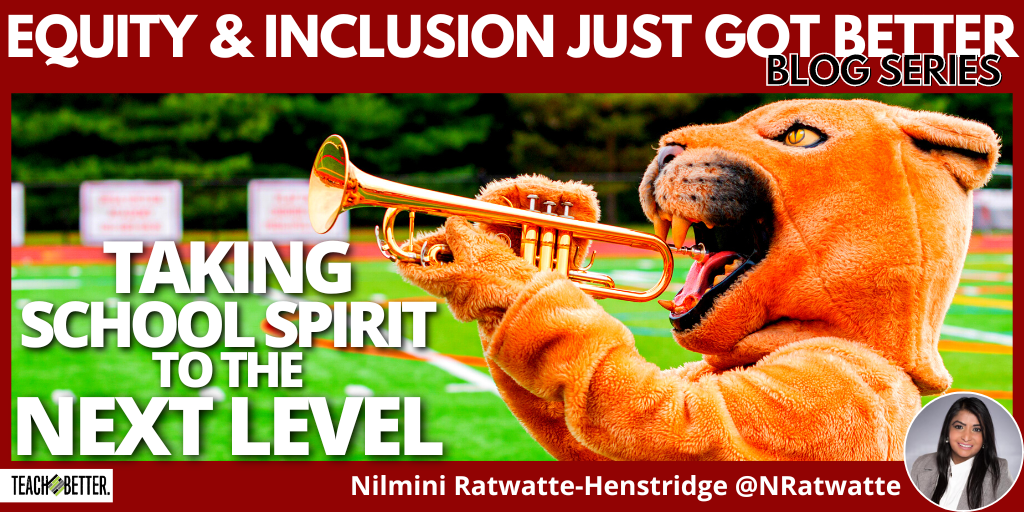TL;DR:
- Building school spirit is essential for fostering positive school culture and values.
- High academic achievements are linked to students’ pride in their school and engagement in school activities.
- Creating strong relationships and empowering student leadership can lead to a positive school climate and impactful events.
- Consider inclusive and affordable strategies for student-centered tasks and events.
This blog was written in collaboration with Frank Rudnesky who is a podcaster and a middle school principal in the United States.
Taking School Spirit to the Next Level!
School spirit is key to building a core set of values in schools. We are writing today from our experience as a teacher and a middle school principal. We want to inspire you and gain insights into what you do to engage school spirit and values and aspire leadership in middle schools. It’s important to consider our perspectives and see if they work at your school so that you can see the positive impact that school spirit initiatives can bring to your school. The first political role I ran for was my high school council’s spirit coordinator because I firmly believe in the research-backed approach of creating a diverse and accepting culture, which fosters connections among all members of the school community.
Setting High Academic Achievements
Students who are interested in school contribute to the school culture. The research points to higher academic achievements when they are proud of their school. “Having seen firsthand the coordination between student achievement and higher levels of school spirit, I’m glad that there is now a set of research that reinforces this key relationship,” said Bob Gardner, Executive Director of the National Federation of State High Schools (NFHS).
This thought frame resonated with me as a middle school educator since each student is unique in their interests and in what they bring to school. Ensuring we reach the most high-risk students and the students who are not as interested in school is of key importance in the middle school age group since it is an influential age in child development. The importance of providing choices to students, allowing them to explore their interests, and making real-life connections creates a balance between school and real-life success. By integrating these two aspects, academic performance can improve significantly. During my brief experience teaching middle school grades 6, 7, and 8 in Ontario, I learned that achieving high math scores in EQAO (Ontario Math and Language testing) requires understanding and programming according to students’ individual needs, setting high standards as examples.
The importance of providing choices to students, allowing them to explore their interests, and making real-life connections creates a balance between school and real-life success. Click To TweetWhen teaching middle school some things I have tried:
- School Council Teams to build student voice through discussions.
- School Sports Teams with the audience as active participants to build spirit.
- School-wide contests and community-building tasks with points given to school teams.
Building Relationships
When your students and colleagues know you care, amazing shifts in climate and culture can occur and/or get better. I knew this as a teacher and professor but really witnessed the transformation as a middle school principal. Probably, because I came in contact with more stakeholders and one of my goals was to interact with the students. I addressed them by their names and interacted in various capacities. So, that’s what I did. In other words, I was committed to relationship building.
Each year before the start of school, we had Eighth Grade Leadership Camp. Part of the day was devoted to declaring a theme for the year and a service platform. For instance, one year our theme was “Project Superhero” and our service platform was the Atlantic City Rescue Mission. We mapped out and planned events for the year focused on our theme. The students even planned the opening day kickoff as we welcomed new students with signs, music, and a “Happy New Year” assembly.
When you allow the students to drive a positive climate and culture by empowering leadership, amazing outcomes are possible.
Relationships are built and connections create opportunities for everyone. During the school year, students plan and facilitate events. When your students and colleagues see everyone chipping in, it becomes part of your positive environment.
One of the best stories that comes to mind is when the students taught me to skateboard. That’s right! I was over fifty years old when I wielded my first longboard! The students challenged me during a service project. They said if I skateboarded with them, they would collect one thousand pairs of new socks for the homeless at the rescue mission.
They built me a board and I learned to ride it. We collected over two thousand pairs of socks! Ironically, I still ride my longboard to this day! You can imagine how events like this created lasting relationships. I’ve been seen riding down the boardwalk at the New Jersey shore in a suit on many occasions: priceless!
I came to the realization that your leadership ability increases exponentially by the number of leaders you create around you. When we began to include ten-year-olds in our leadership thought process, it was common sense! I taught every student a lesson in leadership during the year. In addition, we had leadership camps and summits. We trained our students to facilitate leadership activities with each other and other schools. That became an unbelievable sense of accomplishment to see all of our adults and students move towards common goals.
Frequently, students contact me and their former teachers to let us know that the leadership training they had in middle school translated to their academic careers as well as their job careers. Inclusion created a new leadership model for our school and especially our students—to have a voice. Leadership becomes timeless. Events and traditions are born that transcend time.
When you create a positive school climate and culture, your performance increases significantly.
People feel like they belong because they have discovered self-dignity that allows other students and colleagues to accept their dignity as a birthright. Respect and positive character become reciprocal and leadership becomes commonplace.
The biggest form of identity theft is telling someone they can’t accomplish something and reducing them to a test score. Conversely, when students and teachers see themselves differently, they see who they can become. They see their full potential. That is a WOW Factor!
There is not one book or super course in leadership that will give you the tools to create or recreate yourself as a leader. Many valuable resources exist but you must reveal what is inside you and act accordingly in a purposeful direction. If you choose to challenge your leadership with love, character, and passion, amazing accomplishments will accompany you and the people around you at every level of your journey. Even on social media, you will find your circle and your circle will find you in a proactive, positive way.
The positive climate and culture that leadership opportunities create will translate to school spirit-oriented ideas.
School Spirit Task-Oriented Ideas With a Middle School Focus
Place emphasis on the school team-building opportunities that engage creativity in students and connect curriculum-driven content to schools.
When I taught middle school I liked bringing in creative ideas from students and building them into the school spirit task to ensure the task was productive and engaging while teaching students something new. For example, the ever-famous middle school task: The Halloween Door Decorating Contest for School Spirit.
We always decorated the door inside the classroom (since for Health and Safety this door can only be up for the judging day). Then we use the decoration for our display board for the week. The door theme that we voted on in the class makes for the most perfect display board that highlights our work in our classroom. I taught a lesson on QR codes and tied in technology to the contest so that students could add QR codes with their favorite Halloween spooky sound or music. Integrating arts with technology to build a layered curriculum as we entered our homeroom ideas into the curriculum is something that engages learning while competing in our school teams.
This is an example from when I taught grade two, where we collaborated with middle school students for a similar task involving our Reading Buddy classmates. The project took longer as each pair consisted of one middle school student and one primary student who aspired to connect their ideas using QR codes. In the end, they created a video message for the door, expressing how much they enjoyed reading together.
Building the Gap on Equitable Access
When teaching middle school is where I saw the gap in financial status the most in Ontario. Students either come to school with those $200 Nike or the $20 shoes. We as teachers, volunteers, and students all know where the gap was. When we can address the issue head-on, we eliminate the potential to have an obstacle.
I want to be transparent and candid, as I usually am when I blog and speak to establish connections. Let’s discuss Middle School Graduation, which revolves heavily around financial aspects as we celebrate the students’ accomplishments and hard work. Whether you are a public school teacher or in a private setting, it can be challenging to witness the process being followed without questioning its implications for students.
Be proactive when you are planning student-centered traditional school tasks:
- Field trips
- Sports events
- School Spirit events
- Graduation
Three Considerations
To ensure affordability and equity in middle school events, it’s essential to maintain a student-centered focus during the planning process.
For instance, let’s consider the widely popular “The Middle School Prom,” which can now become financially burdensome for many families. How can we implement systematic changes that prioritize the inclusion and well-being of every student?
Ask yourself who can afford it and who can’t!
Consider things such as the cost of the dress or tux, dinner, dance, and possibly a graduation field trip.
Diving a little bit deeper into reflection: In the middle school I taught at, the dress would be $200. The cost of a ticket would be $75, and the grade trip to Montreal or Ottawa via bus with classmates would be $600.
When I was teaching grade 8, right at the start of the planning for this trip, I knew half my class would be not attending because they can’t afford what is traditionally and historically done in middle schools in Ontario. I may not be the most popular teacher when I question traditional practice, but I was the most popular teacher among students because I always thought of them first.
To critically examine this practice, we must ask ourselves: Are we organizing this event with the students’ enjoyment in mind, or are we merely adhering to standard procedures? It’s crucial to consider the financial implications for every family and to be compassionate and accommodating in celebrating each student’s middle school achievement. Through this reflective journey in blogging, I hope you, as a reader, will understand the significance of empathizing with families and prioritizing inclusion before sending event invitations to those who may face financial constraints.
Find Solutions Ahead
- How can we get corporate funding to substitute the cost?
- Can we give a different cost to students who can’t afford it?
- Build connections while understanding the community you teach.
- Which community partners can you reach out to for help?
Considering the financial gap and leveling the playing field in how we work with families is of key importance when we encourage conversions on finances and affordability.
[scroll down to keep reading]Get Feedback
- Honest feedback from students will be a good starting point.
- Feedback builds the next successful event.
- Document the knowledge for statistical purposes for the school.
Recently, I had the privilege of presenting to a group of Chinese Canadian students. During my presentation, I was delighted to receive immediate feedback, which encouraged active participation, student voice, and choice. I highly value community development and believe in creating reflective spaces that foster courageous conversations, allowing us to connect through networking. As educators, we excel at nurturing leaders within our communities. I encourage you to join me in working on these aspects at the Rising Dragons Training sessions.
Here is the QR Code for you to check out the Instagram reel for the session!

A special thank you to Frank Rudnesky who connected with me on social media to collaborate on this blog!
Blog Reflection Questions
- How are you going to change your educational practices to make them more inclusive?
- If you were to plan a graduation or a prom, what would you do differently?
- Think about one thing you would share with another teacher so that you inspire them to do things a bit differently with an equity point of view.
Research conducted by Varsity Brands highlights the correlation between school spirit and student achievement, involvement, and confidence.
About Nilmini Ratwatte-Henstridge
Nilmini lives in Ontario, Canada. She was born in Sri Lanka is immigrated Canada. Educator at heart, she is passionate about equity, inclusion, social justice and human rights in education.
She believes in understanding people as she travels to explore cultures in our world during her spare time, loves cooking at home and trying out new flavours, and continues to follow the latest fashion news!
Nilmini loves staying connected with global educators via social media: author, blogger, podcaster and most importantly, just exploring life.





